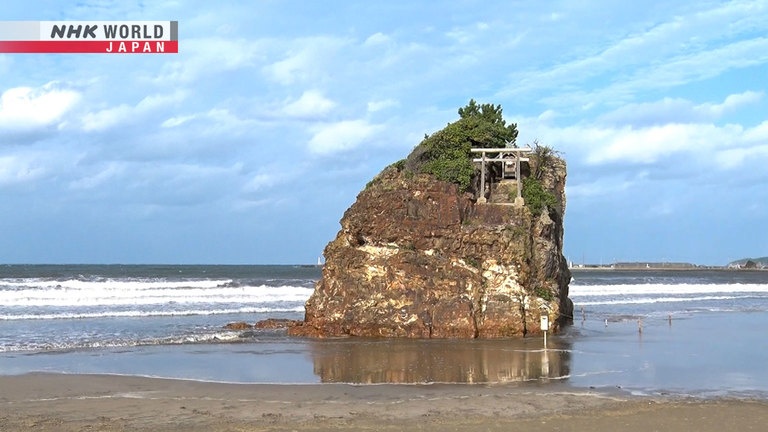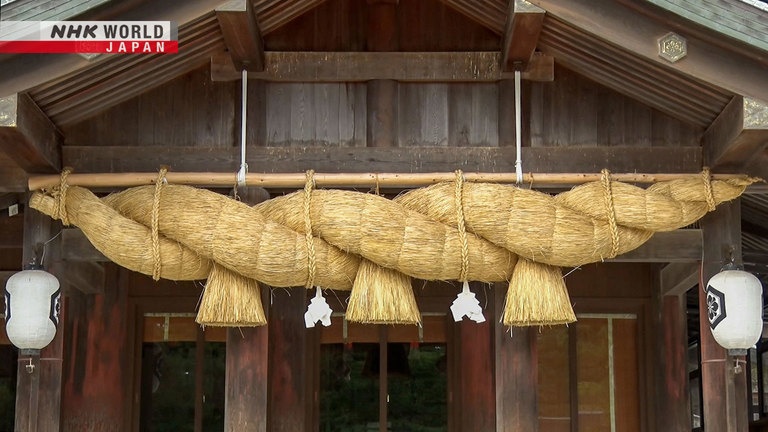Izumo: Home of the Gods
*First broadcast on December 7, 2023.
Each year, Japan's deities are said to gather in Izumo in western Japan. We visit Izumo Taisha, a shrine with a millennium of history, and explore a land with deep connections to the distant past.



Transcript
Japanology Plus
A beautiful white sand beach.
This special, sacred location is
associated with ancient tales.
Hello, and welcome
to Japanology Plus. I'm Peter Barakan.
I'm in Izumo in western Japan, an area
that's shrouded in myth and legend.
Izumo's regarded as the gathering
place for Japan's many deities,
and stories related to them are deeply
rooted in local life and culture.
In recent years, new information
has come to light suggesting that
a huge shrine, mentioned in myth
and later recorded in ancient documents,
actually existed.
Today, in the first of two episodes
about Izumo, we'll delve into its secrets.
Izumo
Home of the Gods
Every November, a ritual takes
place here on Inasa Beach.
Its purpose is to welcome
the “kami,” Japan's deities.
They have long been said to congregate
in this part of the country, once a year.
The beach is part of Izumo,
a city 600 kilometers west of Tokyo,
in Shimane Prefecture.
Upon arrival, the deities make their way
from the beach to a nearby shrine…
Izumo Taisha.
This shrine has been revered for
centuries as a divine meeting place.
It's a prestigious facility with
over a thousand years of history.
Oh, this approach to
the shrine is really long.
Japanese shrines always have an approach;
it's usually much more narrow,
and you can generally see
the shrine as soon as you get in.
I can't even see it.
At last, we approach the hall of worship.
The gigantic, braided straw rope
is particularly eye-catching.
It's called a “shimenawa.”
This one is six meters in length,
and weighs about a thousand kilograms.
It marks the boundary between
our world and the realm of the divine.
Around 5 million people
visit Izumo Taisha each year.
At a typical shrine, it's customary to
bow twice, clap twice, and bow again.
But here, it's different.
At Izumo Taisha, you clap four times.
Peter follows the custom as he
prays for safety on his travels.
The act of clapping reveals something
about Japan's outlook on the divine.
- Good morning.
- Hello.
I'm the curator of the Shimane Museum
of Ancient Izumo.
Nice to meet you.
You too.
Oka Kozo is a leading expert
on Izumo Taisha,
and the customs associated with it.
What's the significance of putting
your hands together like that?
Clapping is an interesting element
of Japanese spiritual practice.
It's about communicating with the unseen.
When you clap, you make a noise.
It's a way to draw attention.
That's the idea behind
clapping during prayer.
I notice that when people
pay their respects,
they put their hands
together four times here,
as opposed to...it's usually twice
in any other shrine I've been to.
The reason why you clap twice at most of
Japan's shrines is because 150 years ago,
the Meiji government established
that as the standard practice.
Clapping more often shows a higher
level of courtesy and respect.
That's why people clap four times here.
It's a tradition that never disappeared.
Visitors to Izumo Taisha
direct their prayers toward a deity
present in the inner sanctum.
The sanctum is a very sacred place,
and only priests are allowed to enter.
Enshrined here at Izumo Taisha
is Okuninushi-no-kami,
the deity believed to have
brought the land into existence.
But there's more to his story.
A distinctive characteristic of this deity
is that he wasn't omniscient
or omnipotent from the beginning.
When he was young,
he was actually quite weak.
But he was really kind.
Whenever someone was in need, he
didn't hesitate to offer them assistance.
He was very compassionate.
The deity's concern for others
even extended to helping
a hare restore its lost fur.
With the support of other deities,
he overcame many challenges,
and went on to create the lands
where people dwell.
It's almost like he was quite human-like.
Yes.
He's not thought to live in a distant
world, totally separate from our own.
He's nearby, unseen, watching out for us.
Local people have always
expressed their affection
by calling him “Okuni-san” for short.
The inner sanctum has extremely
distinctive architecture.
Here we are.
This is the best view of the building.
And that magnificent roof is all made
out of tiny little pieces of wood.
Well, it's actually made from cypress
bark, which is stripped from trees,
and cut to around 1.2 meters long.
Then these thin pieces
are layered on each other.
640,000 pieces.
The inner sanctum is
a large wooden building
that's 24 meters tall
at its highest point.
But stories tell of an even taller
structure that once stood here.
Once upon a time, Okuninushi-no-kami
was visited by divine messengers.
They negotiated with him to
hand control of the earthly realm
to Amaterasu-omikami, the sun deity.
But in return, he requested the
construction in Izumo of a huge sanctum,
as tall as one in the heavenly realm.
Over the centuries,
the shrine was rebuilt many times,
and is said to have become
the Izumo Taisha we see today.
Archaeological evidence of one
tall structure has actually been found.
What is this?
Okuninushi-no-kami was housed
in a structure built here.
There were pillars in these spots.
Oh, so there were...
what, three pillars here?
There were three huge tree trunks.
They were tied together to form a set,
and used as a pillar.
In effect, that pillar had
a diameter of three meters.
Three meters. OK.
This unexpected information
came to light in the year 2000.
During construction work,
three tree trunks were excavated,
and discovered to be around 800 years old.
Their positioning
matched an arrangement
shown in blueprints of
a bygone structure at Izumo Taisha.
How tall would it have been?
It's said that the sanctum
was 48 meters off the ground.
But judging by the size of the pillars,
it could have been even taller.
For several years now, visitors have been
able to use an augmented reality app
to see an image of that ancient structure.
OK, here we go.
What?!
Oh, and it slopes down.
Down to the ground. Wow, that's strange.
What was this inner sanctum actually like?
Let's take a closer look
at the excavated tree trunks.
They're on permanent display
in the Shimane Museum of Ancient Izumo.
Ohh.
I can imagine how excited you must have
been when you saw that in the ground.
With regular wooden buildings,
you'd have a material like
stone as a foundation.
And pillars would be
erected on top of that.
That's typical.
With usual houses, yes, yes.
Inserting pillars directly
into the ground like this
is a simple, ancient technique.
But it's flawed.
If wood is in contact with the ground,
it will absorb water.
Because of that, over time, it will rot.
That disrupts the balance of a building,
and has a drastic impact on its longevity.
After about 30 years, it will be unusable.
And we're talking about the 13th century,
which means that the technology
is very limited.
Which means that you had to have
an enormous number of people
involved in building this thing.
Yes.
Local people would have worked
together to find suitable materials.
And they would also have
built the structure.
According to old blueprints,
the sanctum itself stood on
a frame of nine sets of pillars
and was connected to a staircase.
The museum has created
a model based on those records.
I mean, just to imagine that is amazing.
The building would have
been 48 meters tall,
with perhaps a 109-meter staircase.
And in a non-urban area like Izumo,
there would be no need to
have a very tall building,
so why was it done?
It was intended to enshrine
a mighty deity,
so it had to be appropriate
for that purpose.
That's what the people who
built it would have thought.
So it wasn't about projecting
an image of their own power.
Rather, it was an expression of reverence,
respect, and gratitude
to a powerful presence.
People built this early structure of
Izumo Taisha
as a physical representation
of those feelings.
It is said that once a year, in November,
deities gather in Izumo from around
Japan for an important meeting.
The scene is depicted
in this 19th-century print.
Okuninushi-no-kami and his peers
facilitate new connections among humans.
They consider plaques
bearing people's names.
Through an extensive discussion,
the deities bring together people
with compatible personalities
and promote positive relationships.
This divine event is called “Kamiarisai,”
and it's been celebrated as an important
festival in Izumo for over 800 years.
One food item associated with the festival
is now consumed throughout Japan.
Zenzai: a sweet dish made
with adzuki beans and mochi.
Historical records show that it evolved
from an older dish, “jinzai mochi,”
that has been consumed in the Izumo area
since ancient times.
The earlier dish originated at Sada Jinja,
a shrine in Izumo with over
a thousand years of history.
The dish is still served at
a shop on the grounds.
Hello.
- Welcome.
- Nice to meet you.
The owner, Kishi Satoru, is a priest
who used to work at the shrine.
A desire to teach people
about jinzai mochi
prompted him to open
the store 15 years ago.
Here you are: jinzai mochi.
Thank you.
Jinzai mochi has the same ingredients
as modern zenzai: adzuki beans and mochi.
The two dishes look identical.
But there's a striking dissimilarity.
Oh, and it tastes completely different.
It's not sweetened.
That's right. It doesn't contain sugar.
This is how it was originally served.
How would it normally have been eaten,
or when would it normally have been eaten?
On special occasions.
The ingredients were prepared
as an offering to the deities.
In particular, it was
a feature of Kamiarisai.
The dish itself was greatly enjoyed
by officials visiting from Kyoto.
When they asked for its name,
they were told: jinzai mochi.
But the locals have a strong accent.
So the visitors thought
the dish was called something different:
“zenzai mochi.”
Japanese being a complicated language,
you have your kanji and there are several
ways of reading them, I should say.
So you write “jinzai,”
which means, “kami ari.”
It means “the gods are all here.”
So the festival is “kami ari,”
but then the food
is called “jinzai mochi,”
and then that becomes “zenzai,” right?
Right.
Adzuki beans and mochi are
traditional gifts for the deities.
In Izumo, jinzai mochi was
also eaten by local people.
It came to be seen as
a form of purification.
A gift that's been presented to
the deities is itself seen as divine.
By consuming it,
you access some of the deity's powers.
Every year, at Kamiarisai,
people still enjoy a bowl of jinzai mochi.
A simple dish with a connection
to the divine.
It's delicious.
Delicious.
An evening performance at a local shrine.
This is kagura: a ceremonial dance.
It has been performed
in Izumo since ancient times.
From the 17th century,
the local style spread, inspiring other
forms of kagura across Japan.
Today, Shimane prefecture has
over 200 kagura groups,
featuring performers of all ages.
Kagura is deeply rooted
in the local community.
Many of the dances depict ancient tales.
And to tell the stories of the deities,
performers wear masks.
We'll visit a man who has been making
those masks for over 60 years.
Ah, good morning. Sugitani-san.
- Nice to meet you.
- Nice to meet you, too.
As a young person,
Sugitani Shigeru became fascinated by
the varied expressions on kagura masks.
And he devoted his life to making them.
Whoa.
The walls of his studio are covered
with examples of his work.
It's amazing.
How many do you think you have?
Around 650.
Whoa.
Most of these masks on this wall here
are actually quite scary looking.
And this Okuninushi-no-kami is really
the only one there who looks kindly.
What's special about him?
He's seen as lucky—a deity
of beneficial connections.
And so that's why he looks so friendly.
Okuninushi-no-kami is seen as
kind-hearted, so his mask bears a smile.
The mask is worn by kagura performers
presenting stories about him.
Here, the messengers of Amaterasu-omikami
ask Okuninushi-no-kami
to relinquish control
of the earthly realm.
What say you?
To the descendants of
Amaterasu-omikami, I entrust this land.
In return, a huge shrine will be
built for Okuninushi-no-kami.
He brings this episode to
a close with an elegant dance.
Not all of the masks are used onstage.
And some look distinctly hostile.
So why does he look so scary?
He may look scary. But he's not evil.
People wearing this costume visit
houses and drive away bad spirits.
That's his role.
Ah, OK.
His name is Bannai.
He features in Izumo Taisha's
annual New Year event.
Despite his fierce expression,
he's known for dispelling evil
and protecting the community.
He drives evil spirits out
of people's homes.
So he's a benevolent figure.
People display these masks
to keep the bad spirits at bay.
But they have to look scary because
they're scaring away devils.
Yes, without a scary face,
he can't do his job.
Smiling wouldn't work!
Many of the masks are extremely elaborate.
Let's take a closer look.
- Is it OK to touch it?
- Go ahead.
It's wood on the inside.
And what's the hair made of?
The beard is horsehair.
And this is from a wild boar.
Kagura masks are carved out of wood.
Each one is made from a single block.
Carving such intense expressions
takes years of experience.
Oh, and the mouth moves as well.
Only the mouth moves, in fact.
With this mask, the eyes don't.
This kind of mask with moving
parts is unique to Izumo.
There really are all kinds
of different expressions.
Are some of them more difficult
to carve than others?
Yes.
Female faces are the hardest.
Such as this one.
Any particular parts of the face
that are difficult to do?
The eyes.
Their orientation and height
need to be just right.
Otherwise it won't work.
Demonic faces feature deep,
detailed carvings.
Adjustments can be made.
But with simple, female faces,
there's no room for error.
Every mask takes a great deal of skill,
but the smooth female ones
pose special challenges.
A single stroke of a chisel can
change the whole expression.
Even now, in his 70s,
Sugitani makes masks every day.
The older I get, the more gratitude
I feel toward the deities.
That feeling just gets deeper.
Some time ago, I had an illness.
It was serious. I almost died.
But now I can work again.
I feel that's thanks to divine support.
Even today, the people of Izumo maintain
a strong relationship with the deities.
Izumo is always referred to as the place
where the many, many Japanese gods
all come together once a year.
The word “god” is always a bit difficult
because people are going to
interpret it in different ways.
The Japanese gods seem to
be a lot more down to earth.
If anything, myths—as in any country,
I suppose—
seem to be like a guide to
how we relate to nature,
and I certainly feel,
having visited the Izumo region,
that I really want to know a lot
more about the Japanese myths.